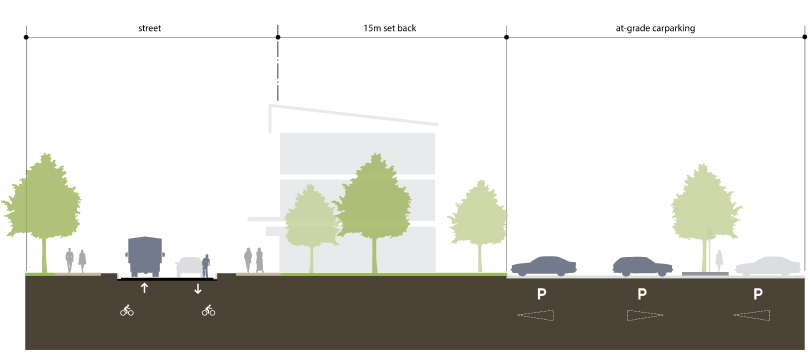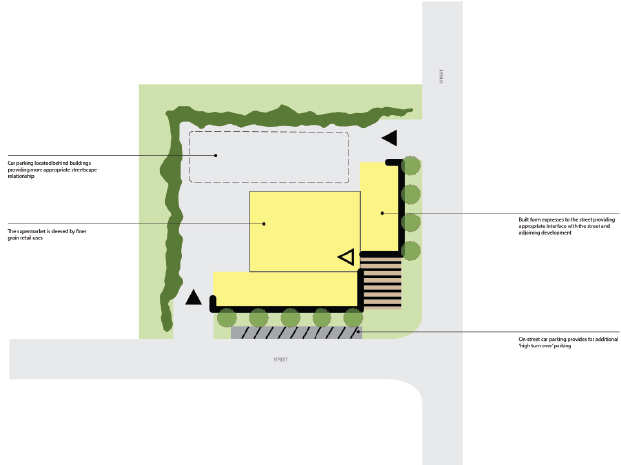Version 2 - Current Planning Scheme
- Citation and commencement
- Part 1 About the planning scheme
- Part 2 State planning provisions
- Part 3 Strategic framework
- Part 4 Local Government Infrastructure Plan (LGIP)
- Part 5 Tables of assessment
- Part 6 Zones
- Part 7 Local plans
- Part 8 Overlays
- Part 9 Development codes
- Part 10 Other plans
- Schedule 1 Definitions
- Schedule 2 Mapping
- Schedule 3 Local Government Infrastructure Plan (LGIP) mapping and tables
- Schedule 4 Notations required under the Planning Act 2016
- Schedule 5 Land designated for community infrastructure
- Schedule 6 Planning scheme policies
- Appendices
6.2.7 Neighbourhood centre
6.2.7.1 Application
This code applies to development where the code is identified as applicable in a table of assessment.
When using this code, reference should be made to section 5.3.2 and where applicable, section 5.3.3 located in Part 5.
6.2.7.2 Purpose
- The purpose of the Neighbourhood Centre zone code is to provide for a small mix of land uses to service residential neighbourhoods. It includes small–scale convenience shopping, professional offices, community services and other uses that directly support the immediate community. Development in this zone must:
- Provide for accessible, convenient and attractive retail, commercial, administrative and community activities at a scale that does not compromise the viability of the Principal centre zone or the Centre zones.
- Provide for clusters of non–residential uses surrounded by residential areas that provide a mix of uses to support the day to day convenience and community needs of surrounding residents.
- Manage the interface between centre activities and adjoining residential activities.
- Promote high quality centre design that maximises access by active and public transport and activates streets and public spaces.
- The purpose of the zone will be achieved through the following overall outcomes:
- Small–scale convenience retail, commercial and community uses servicing the local community are provided. Large format retail uses are not supported in this zone.
- Limited residential uses such as dwelling units can occur in conjunction with centre activities.
- Limited after hours activities are supported where compatible with surrounding residential activities.
- Development is designed to incorporate sustainable practices including maximising energy efficiency, water conservation and public/active transport use.
- Development provides a high level of amenity and is reflective of the surrounding character of the area.
- Development encourages public transport accessibility and use, walking and cycling.
- Development has access to development infrastructure and essential services.
- Development responds to land constraints, including but not limited to topography, bushfire and flooding.
- Natural features such as creeks, gullies, waterways, wetlands, habitats, vegetation and bushland are retained, enhanced and buffered from the impacts of adjacent uses and any unavoidable impacts are minimised through location, design, operation and management requirements.
6.2.7.3 Assessment benchmarks
Table 6.2.7.3.1—Accepted development subject to requirements and assessable development
| Performance outcomes | Acceptable outcomes |
|---|---|
|
Use – Caretaker's accommodation |
|
|
PO1 Development:
|
AO1.1 No more than 1 caretaker's accommodation unit is established on the site. |
|
AO1.2 Caretaker's accommodation is a maximum of 100m2 GFA. |
|
|
AO1.3 Caretaker's accommodation is located above the ground floor level, or to the rear of ground level business activities |
|
|
AO1.4 Caretaker's accommodation is provided with a private open space area which:
|
|
| Use – Dwelling unit | |
|
PO2 Development does not compromise ground level business activities being established. |
AO2 Dwelling units are located either above the ground floor level, or to the rear of ground level business activities. |
|
PO3 Development must provide sufficient and accessible open space for residents needs. |
AO3 Development provides a minimum of 16m2 private open space for each dwelling with a minimum dimension of 3m in any direction. |
|
Uses – Food and drink outlet and Club |
|
|
PO4 Hours of operation are limited to minimise nuisance to any surrounding residential uses. |
AO4 Hours of operation are limited to between 7am and 10pm. |
| Use – Sales office | |
|
PO5 The use does not adversely impact on the amenity of the surrounding land uses and local character. |
AO5.1 Development of the sales office is in place for no more than 2 years. |
|
AO5.2 There are a maximum of 2 employees on site at any one time. |
|
| Scale | |
|
PO6 Retail, commercial and community based development:
|
AO6.1 The combined area of the neighbourhood centre including all existing and proposed shops, offices, service industries, health care services and food and drink outlets does not exceed a total GFA of 1,500m2. Note—This acceptable outcome does not apply if only involving the reuse of an existing building. |
|
AO6.2 GFA of the following uses does not exceed:
|
|
| For all assessable development | |
|
Building height (if involving building work) |
|
|
PO7 Building height:
|
AO7 Building height does not exceed 8.5m |
|
Land use and tenancy mix |
|
|
PO8 Development provides for a range of small scale retail, commercial, community, entertainment and recreation activities through a mix of building types and tenancy sizes. |
No acceptable outcome is nominated. |
|
Centre design |
|
|
PO9 Development:
|
No acceptable outcome is nominated. |
|
PO10 Buildings are designed to:
|
No acceptable outcome is nominated. |
|
PO11 Design elements contribute to an interesting and attractive streetscape and building through:
|
No acceptable outcome is nominated. |
|
PO12 Building caps and rooftops contribute to the architectural distinction of the building, and effectively screen service structures, lift over–runs, plant and equipment. |
No acceptable outcome is nominated. |
|
PO13 Development is designed to facilitate the safety and security of people and property having regard to:
Note—Applicants should have regard to Crime Prevention through Environmental Design Guidelines for Queensland. |
No acceptable outcome is nominated. |
| Street interface | |
|
PO14 Buildings are oriented to address all street frontages, public open space and public areas to:
|
No acceptable outcome is nominated. |
|
PO15 Buildings and pedestrian entries:
|
No acceptable outcome is nominated. |
|
PO16 Buildings includes windows and openings to:
|
No acceptable outcome is nominated. |
|
PO17 Development contributes towards high quality streetscape outcomes that integrate effectively with the street and along key pedestrian and cycle routes. |
No acceptable outcome is nominated. |
|
PO18 Buildings include awnings that:
|
No acceptable outcome is nominated. |
|
PO19 Development must ensure safe, convenient and legible connections and pathways are provided:
|
No acceptable outcome is nominated. |
| Landscape design | |
|
PO20 Landscape elements are integrated in the building design through planting at various levels including on top of podiums, rooftops and within storeys. Note—Refer also to the Landscaping code. |
No acceptable outcome is nominated. |
|
PO21 Landscape treatments includes hard and soft elements that:
Note—Refer also to the Landscaping code. |
No acceptable outcome is nominated. |
| Amenity | |
|
PO22 Development is located, designed and operated so that adverse impacts on privacy and amenity on nearby land in a residential zone are minimised. |
AO22.1 Buildings are set back 3m from any boundary shared with a residential zone. |
|
AO22.2 A 1.8m high solid screen fence is provided along all boundaries shared with a residential zone. |
|
|
AO22.3 A landscaped buffer with a minimum width of 2m and consisting of dense screen planting is provided along all boundaries shared with a residential zone. |
|
|
AO22.4 Windows that have a direct view into an adjoining residential use are provided with fixed screening that is a maximum of 50% transparent to obscure views and maintain privacy for residents. |
|
|
PO23 Development minimises impacts on surrounding land and provides for an appropriate level of amenity within the centre, having regard to:
Note—Applicants may be required to engage specialists to provide detailed investigations into the above matters in order to demonstrate compliance with this performance criterion. |
No acceptable outcome is nominated. |
|
PO24 All uses are located, designed, orientated and constructed to:
|
No acceptable outcome is nominated. |
| Car parking and access | |
|
PO25 Parking and loading areas do not visually dominate the streetscape. |
AO25.1 Parking areas are:
Note—Refer also to Diagram 6.2.7.3.1—Parking design in neighbourhood centres. |
|
AO25.2 Vehicle loading areas are screened from footpaths, streets and public areas by fences with screening at least 1.5m in height and are 50% visually permeable. |
|
|
Storage areas |
|
|
PO26 Ancillary storage of goods or materials must be located in a manner that does not detract from the visual amenity of the local area. |
AO26 Equipment, materials, goods and/or, machinery used on site are either:
|
|
Effects of development |
|
|
PO27 Development responds sensitively to on–site and surrounding topography, coastal foreshores, waterways, drainage patterns, utility services, access, vegetation and adjoining land use, such that:
|
No acceptable outcome is nominated. |
|
Use – Child care centre |
|
|
PO28 Development is:
|
No acceptable outcome is nominated. |
|
PO29 Where adjoining a residential use or land in the residential zone, development must ensure residential amenity is maintained on adjoining properties. |
AO29.1 Development provides a 1.8m acoustic screen fence where adjoining a residential use. |
|
AO29.2 Hours of operation are limited to between 6am and 7pm daily. |
|
|
PO30 Development minimises:
|
AO30.1 The use is not accessed from:
|
|
AO30.2 Parking spaces are located so that children are not required to cross the driveway or vehicular access way to reach the building. |
|
Diagram 6.2.7.3.1—Parking design in neighbourhood centres

Example 1—Correct parking treatment










